Abstract
The purpose of this study was to predict the color change of heat-treated wood during artificial weathering by an artificial neural network (ANN) model. Chemical component analysis was used to analyze the origin of color change of the heat-treated wood. The network included an input layer consisting of three input nodes, namely, the weathering exposure time, heat treatment temperature, and heat-treated wood species, a hidden layer using six neurons and an output layer consisting of one output node, namely heat-treated wood color. A hyperbolic tangent sigmoid transfer function was used in the hidden layer, and the training algorithm was the Levenberg–Marquardt backpropagation. According to the results, the mean absolute percentage errors (MAPE) were 8.17, 9.70, and 9.85% for the prediction of color change (ΔE) for training, validation and testing data sets, respectively. Determination coefficients (R2) above 0.92 were obtained with the proposed ANN model for all data sets. These results showed that the ANN model can be successfully used for predicting the color change of heat-treated wood during artificial weathering. FTIR results showed that the color change of heat-treated wood during artificial weathering is due to the change in the chemical composition, especially the photodegradation of lignin and wood extractives.







Similar content being viewed by others
References
Armondo G (1997) Chemical and UV–Vis spectroscopic study on kiln brown stain formation in Radiata pine. In: Proceedings of the 9th international symposium of wood and pulping chemistry. Montreal, Canada, June 9–12, 1997. pp 70.1–70.5
Ayadi N, Lejeune F, Charrier F, Charrier B, Merlin A (2003) Color stability of heat-treated wood during artificial weathering. Holz Roh- Werkst 61:221–226
Aydin G, Karakurt I, Hamzacebi C (2014) Artificial neural network and regression models for performance prediction of abrasive waterjet in rock cutting. Int J Adv Manuf Tech 75:1321–1330
Bekhta P, Niemz P (2003) Effect of high temperature on the change in color, dimensional stability and mechanical properties of spruce wood. Holzforschung 57:539–546
Canakci A, Ozsahin S, Varol T (2012) Modeling the influence of a process control agent on the properties of metal matrix composite powders using artificial neural networks. Powder Technol 228:26–35
Colom X, Carrillo F, Nogués F, Garriga P (2003) Structural analysis of photodegraded wood by means of FTIR spectroscopy. Polym Degrad Stabil 80:543–549
Demirkir C, Ozsahin S, Aydin I, Colakoglu G (2013) Optimization of some panel manufacturing parameters for the best bonding strength of plywood. Int J Adhes Adhes 46:14–20
Vartanian E, Barres O, Roque C (2015) FTIR spectroscopy of woods: a new approach to study the weathering of the carving face of a sculpture. Spectrochim Acta A 136:1255–1259
Fernandez FG, Esteban LG, DePalacios P, Navarro M, Conde M (2008) Prediction of standard particleboard mechanical properties utilizing an artificial neural network and subsequent comparison with a multivariate regression model. Forest Syst 17:178–187
Fernandez FG, Palacios P, Esteban LG, Garcia-Iruela A, Rodrigo BG, Menasalvas E (2012) Prediction of MOR and MOE of structural plywood board using an artificial neural network and comparison with a multivariate regression model. Compos Part B-Eng 43:3528–3533
Feist WC, Rowell RM, Barbour RJ (1990) Outdoor wood weathering and protection. Am Chem Soc 255:263–289
Haghbakhsh R, Adib H, Keshavarz P, Koolivand M, Keshtkari S (2013) Development of an artificial neural network model for the prediction of hydrocarbon density at high-pressure, high-temperature conditions. Thermochim Acta 551:124–130
Hamed MM, Khalafallah MG, Hassanien EA (2004) Prediction of wastewater treatment plant performance using artificial neural networks. Environ Modell Softw 19:919–928
Hamzaçebi C, Akay D, Kutay F (2009) Comparison of direct and iterative artificial neural network forecast approaches in multi-periodic time series forecasting. Expert Syst Appl 36:3839–3844
Hon DN-S, Minemura N (2000) Color and discoloration. Wood Cell Chem 385–442
Huang X, Kocaefe D, Kocaefe Y, Boluk Y, Pichette A (2012) A spectrocolorimetric and chemical study on color modification of heat-treated wood during artificial weathering. Appl Surf Sci 258:5360–5369
Icel B, Guler G, Isleyen O, Beram A, Mutlubas M (2015) Effects of industrial heat treatment on the properties of spruce and pine woods. BioResources 10:5159–5173
Kalogirou SA (2001) Artificial neural networks in renewable energy systems applications: a review. Renew Sust Energ Rev 5:373–401
Kishino M, Nakano T (2004) Artificial weathering of tropical woods. Part 1: Changes in wettability. Holzforschung 58(5):552–557
Kishino M, Nakano T (2004) Artificial weathering of tropical woods. Part 2: Color change. Holzforschung 58(5):558–565
Kotilainen R, Toivanen T, Alén N (2000) FTIR monitoring of chemical changes in softwood during heating. J Wood Chem Technol 20:307–320
Luis G, Francisco G, Palacios P (2009) MOE prediction in Abies pinsapo Boiss. timber: application of an artificial neural network using non-destructive testing. Comput Struct 87:1360–1365
Mitsui K, Takada H, Sugiyama M, Hasegawa R (2001) Changes in the properties of light-irradiated wood with heat treatment. Part 1. Effect of treatment conditions on the change in color. Holzforschung 55:601–605
Nguyen THV, Nguyen TT, Ji XD, Nguyen VD, Gui M (2018) Enhanced bonding strength of heat-treated wood using a cold atmospheric-pressure nitrogen plasma jet. Eur J Wood Prod 76:1697–1705
Nguyen THV, Nguyen TT, Ji XD, Guo M (2018) Predicting color change in wood during heat treatment using an artificial neural network model. BioResources 13:6250–6264
Nuopponen M, Vuorinen T, Jämsä S, Viitaniemi P (2003) The effects of a heat treatment on the behaviour of extractives in softwood studied by FTIR spectroscopic methods. Wood Sci Technol 37:109–115
Nuopponen M, Wikberg H, Vuorinen T et al (2004) Heat-treated softwood exposed to weathering. J Appl Polym Sci 91:2128–2134
Peng Y, Liu R, Cao J (2015) Characterization of surface chemistry and crystallization behavior of polypropylene composites reinforced with wood flour, cellulose, and lignin during accelerated weathering. Appl Surf Sci 332:253–259
Sagıroglu S, Besdok E, Erler M (2003) Artificial intelligence applications in engineering-1: Artificial neural networks. Ufuk Books Stationery, Kayseri
Sehlstedt-Persson M (2003) Colour responses to heat-treatment of extractives and sap from pine and spruce. In: International IUFRO Wood Drying Conference 459–464
Samarasinghe S, Kulasiri D, Jamieson T (2007) Neural networks for predicting fracture toughness of individual wood samples. Silva Fennica 41:105–122
Sofuoglu SD (2015) using artificial neural networks to model the surface roughness of massive wooden edge-glued panels made of Scotch Pine (Pinus sylvestris L.) in a machining process with computer numerical control. BioResources 10:6797–6808
Sundqvist B (2004) Colour changes and acid formation in wood during heating, Luleå tekniska universitet
Sundqvist B, Morén T (2002) The influence of wood polymers and extractives on wood colour induced by hydrothermal treatment. Eur J Wood Prod 60:375–376
Temiz A, Terziev N, Eikenes M, Hafren J (2007) Effect of accelerated weathering on surface chemistry of modified wood. Appl Surf Sci 253:5355–5362
Tiryaki S, Coşkun H (2014) Predicting modulus of rupture (MOR) and modulus of elasticity (MOE) of heat treated woods by artificial neural networks. Measurement 49:266–274
Tuong VM, Li J (2010) Effect of heat treatment on the change in color. BioResources 5:1257–1267
Xing D, Wang S, Li J (2015) Effect of artificial weathering on the properties of industrial-scale thermally modified wood. BioResour 10:8238–8252
Yildiz S, Tomak ED, Yildiz UC, Ustaomer D (2013) Effect of artificial weathering on the properties of heat treated wood. Polym Degrad Stabil 98:1419–1427
Zhang G, Patuwo BE, Hu MY (1998) Forecasting with artificial neural networks: the state of the art. Int J Forecast 14:35–62
Acknowledgements
This work is financially supported by Applied Technology Research and Development Program of Heilongjiang Province (GX16A002).
Author information
Authors and Affiliations
Corresponding author
Additional information
Publisher's Note
Springer Nature remains neutral with regard to jurisdictional claims in published maps and institutional affiliations.
Rights and permissions
About this article
Cite this article
Nguyen, T.T., Van Nguyen, T.H., Ji, X. et al. Prediction of the color change of heat-treated wood during artificial weathering by artificial neural network. Eur. J. Wood Prod. 77, 1107–1116 (2019). https://doi.org/10.1007/s00107-019-01449-0
Received:
Published:
Issue Date:
DOI: https://doi.org/10.1007/s00107-019-01449-0




